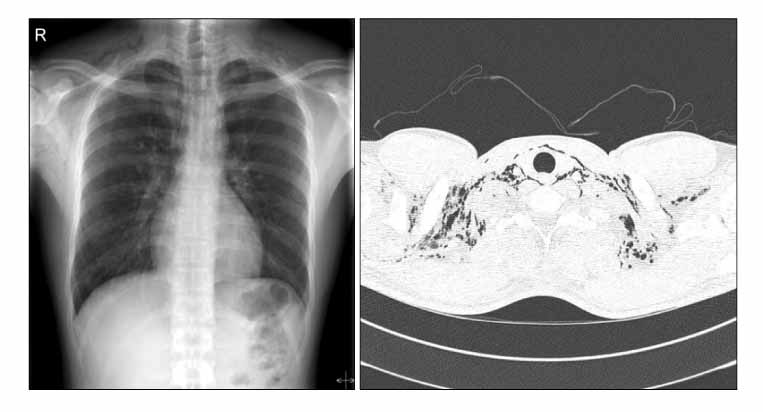Tuberc Respir Dis.
2008 Sep;65(3):222-224.
A Case of Spontaneous Pneumomediatsinum during Taekwondo
- Affiliations
-
- 1Department of Internal Medicine, Eulji University School of Medicine, Daejeon, Korea. hms43@eulji.ac.kr
Abstract
- Spontaneous pneumomediastinum is defined as a clinical syndrome thatos characterized by the presence of air in the mediastinal space, which is not due to an old previous injury or surgery. The condition is caused by a sustained increase in the intraalveolar and intrabronchial pressure with extravasated air dissecting along the perivascular spaces of the mediastinum. This is an uncommon complication of sports activity. The most common symptom is chest pain. This diagnosis should be considered for younger people who present with pleuritic chest pain or dyspnea and a characteristic crackling feel (known as subcutaneous crepitation) when touching of the skin covering the chest wall or neck, and they look otherwise well with normal vital signs. Usually no treatment is required, but the mediastinal air will be absorbed faster if the patient inspires high concentrations of oxygen. We present here a case of spontaneous pneumomediastinum that occurred during a Taekwondo match, along with a review of the relevant literature.
Keyword
MeSH Terms
Figure
Reference
-
1. Pierce MJ, Weesner CL, Anderson AR, Albohm MJ. Pneumomediastinum in a female track and field athlete: a case report. J Athl Train. 1998. 33:168–170.2. Fallon KE, Foster K. Pneumomediastinum in a surf lifesaver. Br J Sports Med. 1996. 30:359–360.3. Campillo-Soto A, Coll-Salinas A, Soria-Aledo V, Blanco-Barrio A, Flores-Pastor B, Candel-Arenas M, et al. Spontaneous pneumomediastinum: descriptive study of our experience with 36 cases. Arch Bronconeumol. 2005. 41:528–531.4. Faust RC. Subcutaneous emphysema during labor. Northwest Med. 1940. 39:24–26.5. Cho H, Choi BM, Jung HK, Park JY, Jang BI, Sunwoo MO, et al. A case of severe asthma complicated with pneumoperitoneum and pneumomediastinum during AMBU ventilation. Tuberc Respir Dis. 2001. 51:585–589.6. Kanetaka K, Tsuji K, Tsuda T, Tamura H, Kitajima J, Kanematsu T. Spontaneous pneumomediastinum: report of a case and review of literature. Acta Med Nagasaki. 2003. 48:67–70.7. Miller WE, Spiekerman RE, Hepper NG. Pneumomediastinum resulting from performing Valsalva maneuvers during marihuana smoking. Chest. 1972. 62:233–234.8. Park JH, Lee YJ, Kang HH, Kim SJ, Koh YS, Lim CM. A case of measles pneumonia complicated by subcutaneous emphysema and pneumomediastinum in an 18-year-old patient. Tuberc Respir Dis. 2001. 51:275–280.9. Park MJ. A case of nonspecific interstitial pneumonia complicated with spontaneous pneumomediastinum, subcutaneous emphysema and pneumatosis interstinalis. Tuberc Respir Dis. 2008. 64:138–143.10. Lorge HJ. The etiology of idiopathic pneumothorax. Am J Med Sci. 1940. 199:635–641.11. Mumford AD, Ashkan K, Elborn S. Clinically significant pulmonary barotrauma after inflation of party balloons. BMJ. 1996. 313:1619.12. Vosk A, Houston CS. Mediastinal emphysema in mountain climbers: report of two cases and review. Heart Lung. 1977. 6:799–805.13. Newcomb AE, Clarke CP. Spontaneous pneumomediastinum: a benign curiosity or a significant problem? Chest. 2005. 128:3298–3302.14. Kaneki T, Kubo K, Kawashima A, Koizumi T, Sekiguchi M, Sone S. Spontaneous pneumomediastinum in 33 patients: yield of chest computed tomography for the diagnosis of the mild type. Respiration. 2000. 67:408–411.15. Abolnik I, Lossos IS, Breuer R. Spontaneous pneumomediastinum: a report of 25 cases. Chest. 1991. 100:93–95.
- Full Text Links
- Actions
-
Cited
- CITED
-
- Close
- Share
- Similar articles
-
- The Effect of Taekwondo Training on Aerobic Capacity, MVO2, ST Slope and QRS Duration
- Rupture of the Iliacus Muscle and Paralysis of the Femoral Nerve during Taekwondo Practice – Report of a Case
- Extensor Hallucis Longus Tendon Rupture in TaeKwonDo Players: Two Case Report
- Successful Treatment of Anterior Knee Impingement Syndrome in Taekwondo Athletes
- The Effects of Taekwondo Training on Brain Connectivity and Body Intelligence



